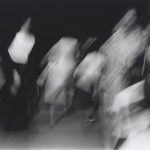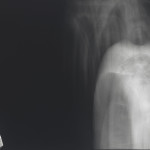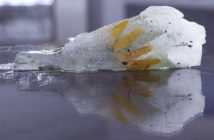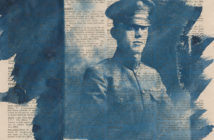Out of the darkness they come, like Orpheus blinking into the light, or that mob of dead souls called up by Odysseus to drink from a puddle of blood. The subjects of these photographs are all, or most of them, ghosts by now. But when Donald Blumberg made these visual records at the front of St. Patrick’s Cathedral in New York between 1965 and 1967, the ancient usages of veil and formality that once marked the Catholic faithful were still intact. The black door behind these figures is not simply a backdrop for their brightness; it is the place from where they carry mysteries out into the ordinary light of day, saints and martyrs disguised as window shoppers. But they are changed, some as by a tilted mirror in God’s fun house, slightly askew and doubled, with the sequence of their movement constructed in the style of the early Renaissance painter Giovanni di Paolo where both time and space shift within a single frame. For others, a blur of movement leaves only the starkest badges of identity, such as a nun’s black and white habit, recognizable. The boundary line between sacred and secular is here indistinct and pliable, with the memory of an antique ritual carried by each of its singular witnesses out into the rush of the present.
In these pictures, Blumberg is an archivist of mundane mysteries; those brief, unguarded moments of revelation on a crowded sidewalk. But he performs a similar task in his collection of images from newspaper pages and television screens. These are experiments in stopping time, with the random and puerile instants which Blumberg records serving as a means of exposing the essential nonsense of the system which treasures them. Under the general heading of “In Their Own Words” given to them by the artist, photographs of TV stills with their closed captioned texts document the arbitrariness of language in a world gorged on images. There is an essential disconnect apparent here; any words might be applied to any of these pictures. And while they can be encountered as distinct and individual works, each of the series that they make up is an argument readable as a whole.
And so, there is the catalog of visual temptations on the sales channels like QVC with its jewelry advertisements, and rulers laid next to pearls in apparent diminishing contradiction of their magnified splendor on the screen. Soap opera myths, fragments of evangelical oratory, real estate offerings that define houses as trophies, and televised poker tournaments with wagers which reach the millions of dollars, all are variations on the suspect American dream. And in a sequence entitled “Before and After,” Blumberg presents transformations of physical appearance as a series of unintentionally comic instructions on achieving conformity with what is the public norm. All of these are exquisitely illustrative of what the Jesuit poet and activist Daniel Berrigan described in our society as “the absurd cacophony of competing claims, the culture of noise, inadvertence, distraction.”
The images drawn from newspaper pages raise a paradoxical question: are these more or less ephemeral made into an independent photograph? Removed from both the context of the printed object and the library periodical room, these are now nostalgic objects, even though they show us to be careful historians of all our atrocities. In one frame, the arc of violence includes the photo of a soldier in Vietnam who, the caption notes, was wounded immediately after the picture was taken, printed beneath a fragment reporting fires and gunshots in the streets of Belfast. Several of Blumberg’s choices of subject document the slaughter of civilians at My Lai in 1969 and its aftermath. But here, an image of the corpses heaped in ditches still breaks through with its resemblance to present horrors.
We have not come far, and so, there is an essential melancholy to all of this work. The most recent narrative that Blumberg freezes into individual frames is the mass murder at the elementary school in Newtown, CT, three years ago. As time has passed, these images now document the useless attempt to find meaning in the event, or to inspire a change of attitudes towards gun violence in this country, even with a picture of the president in tears. It is possible that Blumberg has seen more of the world's unsettling truths than he ever wanted to, but he persists in his photography, knowing that there are those who have not yet seen enough of them.
- Untitled, from the series Daily Photographs, 1969–70. Gelatin silver print. Yale University Art Gallery, Janet and Simeon Braguin Fund. © Donald Blumberg
- Untitled, from the series In Front of Saint Patrick’s Cathedral, 1965–67. Gelatin silver print. Yale University Art Gallery, Janet and Simeon Braguin Fund. © Donald Blumberg
- Untitled, from the series In Front of Saint Patrick’s Cathedral, 1965–67. Gelatin silver print, 5 1/8 x 7 1/2 in. (13 x 19 cm). Yale University Art Gallery, Janet and Simeon Braguin Fund. © Donald Blumberg
- Untitled, from the series In Front of Saint Patrick’s Cathedral, 1965–67. Gelatin silver print, 6 9/16 x 16 5/8 in. (16.6 x 42.3 cm). Yale University Art Gallery, Janet and Simeon Braguin Fund. © Donald Blumberg
- Untitled [The Family], from the series In Front of Saint Patrick’s Cathedral, 1965–67. Gelatin silver print, 15 3/8 x 23 1/16 in. (39.1 x 58.5 cm). Yale University Art Gallery, Janet and Simeon Braguin Fund. © Donald Blumberg
"Donald Blumberg Photographs: Selections for the Master Sets" is on view at the Yale University Art Gallery through November 22, 2015.









